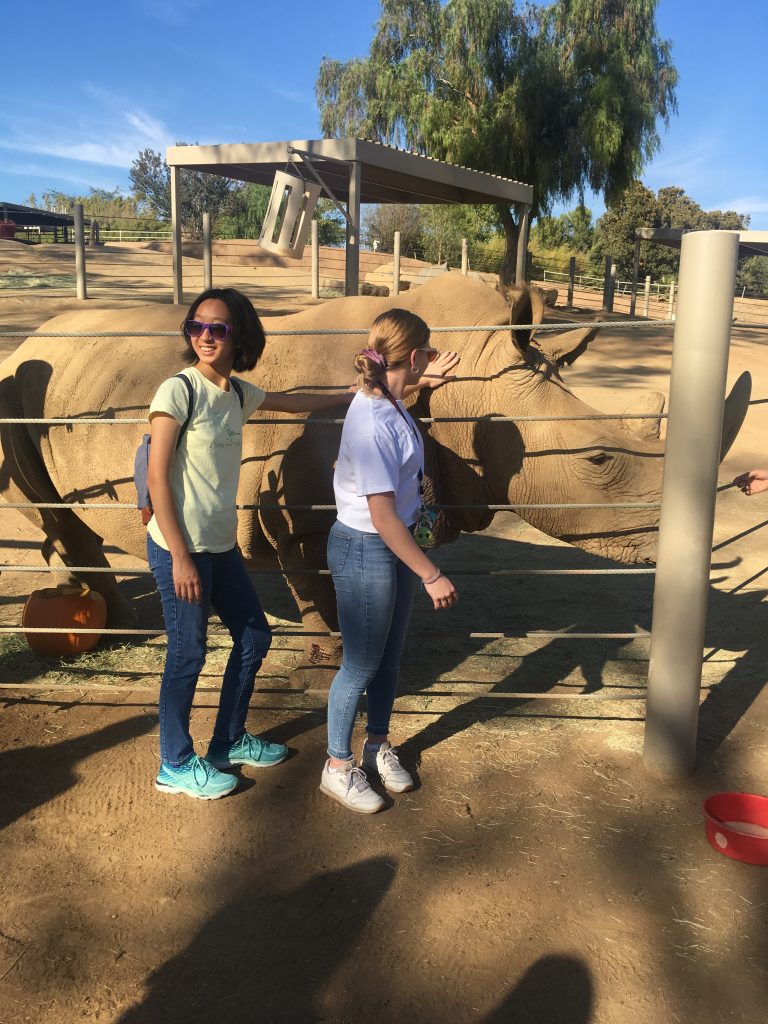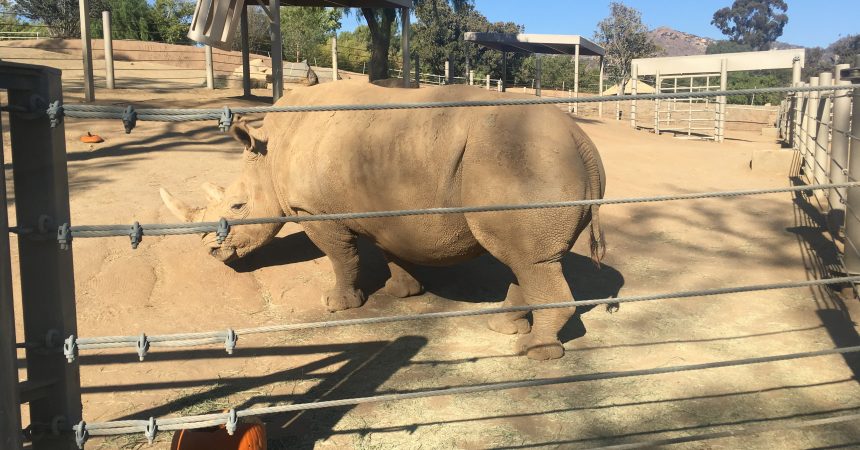Zoo InternQuest is a seven-week career exploration program for San Diego County high school juniors and seniors. Students have the unique opportunity to meet professionals working for the San Diego Zoo, Safari Park, and Institute for Conservation Research, learn about their jobs, and then blog about their experience online. Follow their adventures here on the Zoo’s website!
 As you may know, poaching and habitat loss have left two lone northern white rhinos in existence. Since both rhinos are female and related to one another, northern white rhinos are functionally extinct.. With no hope of reviving this species through natural breeding, what is the San Diego Zoo doing to combat its extinction? At the moment, conservation efforts are focusing on perfecting artificial insemination of southern white rhinos. Artificial insemination is a process in which southern white rhino semen is manually injected into a female southern white rhino’s uterus. Successful artificial insemination will produce a southern white rhino calf, and more importantly, it will indicate that the mother is fertile and able to carry a calf to term. Once these methods have been perfected, the focus will then shift to in vitro fertilization. In vitro fertilization is a process in which a northern white rhino embryo created in a lab setting is placed in a southern white rhino surrogate. Successful in vitro fertilization would result in a northern white rhino calf. Although the team is far from the in vitro fertilization stage, the work with southern white rhinos today will provide valuable information that could help revive the northern white rhino tomorrow.
As you may know, poaching and habitat loss have left two lone northern white rhinos in existence. Since both rhinos are female and related to one another, northern white rhinos are functionally extinct.. With no hope of reviving this species through natural breeding, what is the San Diego Zoo doing to combat its extinction? At the moment, conservation efforts are focusing on perfecting artificial insemination of southern white rhinos. Artificial insemination is a process in which southern white rhino semen is manually injected into a female southern white rhino’s uterus. Successful artificial insemination will produce a southern white rhino calf, and more importantly, it will indicate that the mother is fertile and able to carry a calf to term. Once these methods have been perfected, the focus will then shift to in vitro fertilization. In vitro fertilization is a process in which a northern white rhino embryo created in a lab setting is placed in a southern white rhino surrogate. Successful in vitro fertilization would result in a northern white rhino calf. Although the team is far from the in vitro fertilization stage, the work with southern white rhinos today will provide valuable information that could help revive the northern white rhino tomorrow.
With the most hands-on involvement, the keepers make sure the rhinos are healthy and happy. On Thursday, we met Jonnie Capiro, the Lead Rhino Keeper at the Nikita Kahn Rhino Rescue Center. Every day, keepers act as advocates for the six female southern white rhinos brought to San Diego from South Africa. These six females are frequently tested while undergoing the artificial insemination process. Ms. Capiro works with other keepers at the Rhino Rescue Center to intensively train each rhino to allow the vets and researchers to conduct ultrasounds and other tests to monitor future or existing pregnancies. Ms. Capiro is the primary trainer for Amani, the largest of the six rhinos. Amani is also one of two rhinos that are carrying calves resulting from artificial insemination. When Amani is ready to give birth, Ms. Capiro will work around the clock to make sure the birth is a success. Most days, Ms. Capiro attends meetings, gives presentations, records health and behavioral details, and cleans Amani’s enclosure. Even though Ms. Capiro gets to work with these amazing animals every day, her work is far from glamorous. Taking care of rhinos means being on her feet all day and learning to be patient. Before acquiring her job at the San Diego Zoo, Ms. Capiro already had lots of animal experience from interning at various zoos and sanctuaries throughout the country. In addition to her undergraduate degree at Whittier College and her master’s degree from George Mason University, Ms. Capiro’s networking with prominent professionals in the field also helped her get where she is now.
In addition to keepers, the Rhino Rescue Project extensively involves veterinarians. The vet team communicates with the keepers to monitor the rhinos’ health and well-being. Since trainers like Ms. Capiro are with the rhinos all day, the trainers can alert the veterinary professionals if there is something unusual about the rhino’s behavior. When the vets conduct a rhino’s rectal ultrasound twice a week and extract the occasional blood or tissue sample, the keeper’s training comes into play. For example, the ultrasounds are conducted in the chute, a small enclosure that restricts the rhino’s movement while the vet is examining the animal. Being able to hold still and allow a human to conduct an intrusive test is not a natural behavior. It is Ms. Capiro’s job to desensitize and acclimate the animal to these circumstances. For instance, if Amani is feeling uncomfortable and fidgeting during an ultrasound, Ms. Capiro must focus on training Amani to remain calm in the chute. Although trainers like Ms. Capiro are not the ones conducting the tests in the chute, her role is crucial in making sure the tests are conducted successfully.
All in all, the San Diego Zoo’s Rhino Rescue initiative requires the help of many people and the skills of many departments. The keepers care for and train the rhinos day in and day out, while the vets work weekly to monitor their health. This group effort in fighting against northern white rhino extinction is what makes this program so special. So one day, if you hear that a northern white rhino calf was born at the San Diego Zoo, you’ll know who worked behind the scenes to save these roaming rhinos.
Nerissa, Careers Team
Week Four, Fall Session 2018


